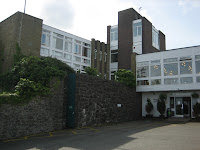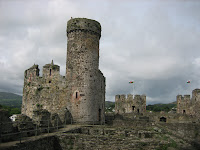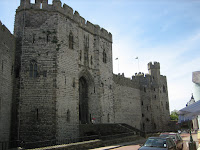Wales - Day Two
The forecast rain held off and we were treated to a cold, (but still sunny) day in Wales. The view from breakfast at the hostel promised a good day ahead.








Conwy castle includes a large wall which surrounded and protected the entire town. It still exists to this day, which means that you have to drive under the walls (via very narrow archways) every time you leave and enter the town centre.


The bridges that span the river were built long after the castle itself (which was built from 1283 to 1287 by Edward I). The central suspension bridge was built in Victorian times, and a rail bridge was constructed at the turn of the 20th century. The road bridge was built in the 1950's. The A55 expressway (ie dual carriageway) runs underneath the river.



The inside of Conwy castle is all ruins, which makes a nice place for all the local birds to make their nests.
After Conwy castle, we headed down the A55 along the northern coastline towards Caernarfon. The A55 itself is quite an engineering marvel. Think of the Great Ocean Raod, but a dual lane carriageway with large sections of the road boring straight through the mountains and cliffs.
Caernarfon is the largest castle in Wales, and was built as a seat of government. Prince Charles had his investiture here when he became Prince of Wales.












Caernarfon Castle houses several museums and displays within its vast mazes of walls.
Lucas found the hectic pace a bit much at times! After Caernarfon we got back onto the A55 and drove across to the island of Anglesey, and headed north to Beaumaris, to see the local castle. Beaumaris Castle is very pretty, but because the money ran out before they managed to finish the battlements, it lacks the imposing nature of the other castles.




Beumaris in Wales was just like at home. Nice beach, a bit pier and friendly locals!








Conwy castle includes a large wall which surrounded and protected the entire town. It still exists to this day, which means that you have to drive under the walls (via very narrow archways) every time you leave and enter the town centre.


The bridges that span the river were built long after the castle itself (which was built from 1283 to 1287 by Edward I). The central suspension bridge was built in Victorian times, and a rail bridge was constructed at the turn of the 20th century. The road bridge was built in the 1950's. The A55 expressway (ie dual carriageway) runs underneath the river.



The inside of Conwy castle is all ruins, which makes a nice place for all the local birds to make their nests.
After Conwy castle, we headed down the A55 along the northern coastline towards Caernarfon. The A55 itself is quite an engineering marvel. Think of the Great Ocean Raod, but a dual lane carriageway with large sections of the road boring straight through the mountains and cliffs.
Caernarfon is the largest castle in Wales, and was built as a seat of government. Prince Charles had his investiture here when he became Prince of Wales.












Caernarfon Castle houses several museums and displays within its vast mazes of walls.
Lucas found the hectic pace a bit much at times! After Caernarfon we got back onto the A55 and drove across to the island of Anglesey, and headed north to Beaumaris, to see the local castle. Beaumaris Castle is very pretty, but because the money ran out before they managed to finish the battlements, it lacks the imposing nature of the other castles.




Beumaris in Wales was just like at home. Nice beach, a bit pier and friendly locals!

0 Comments:
Post a Comment
<< Home